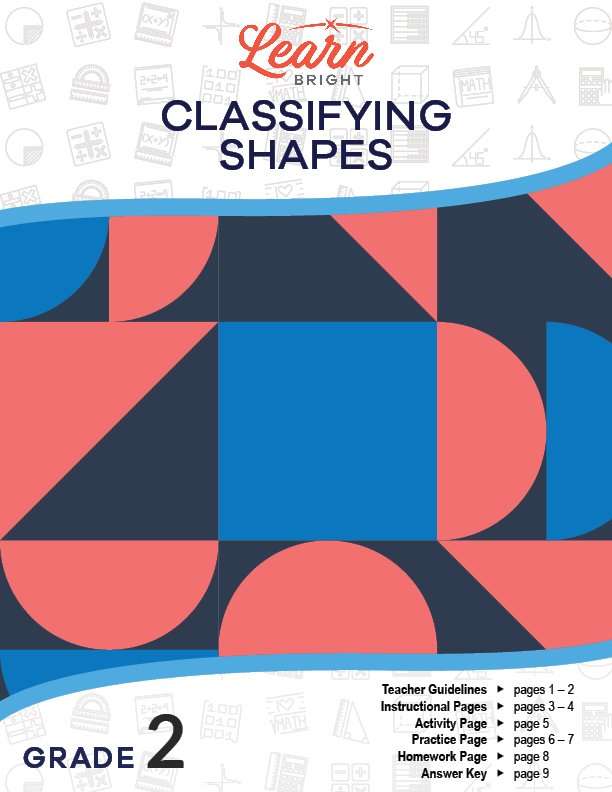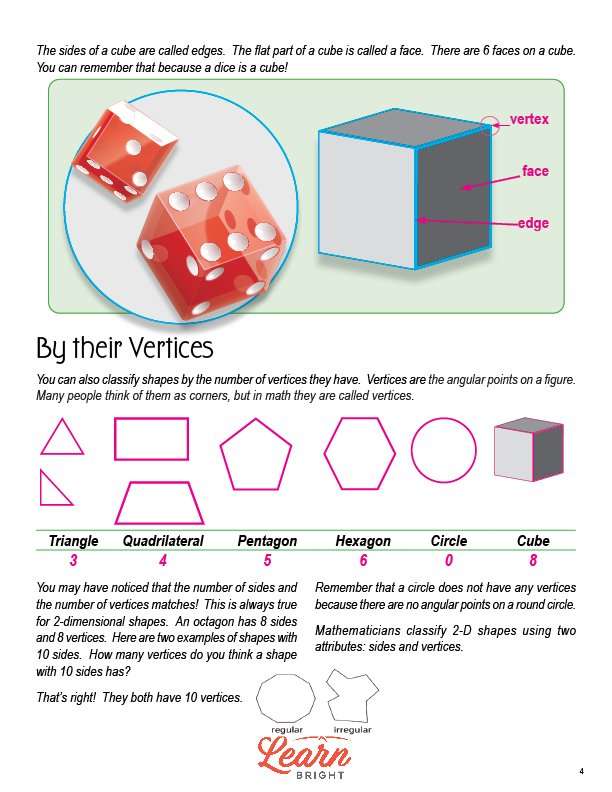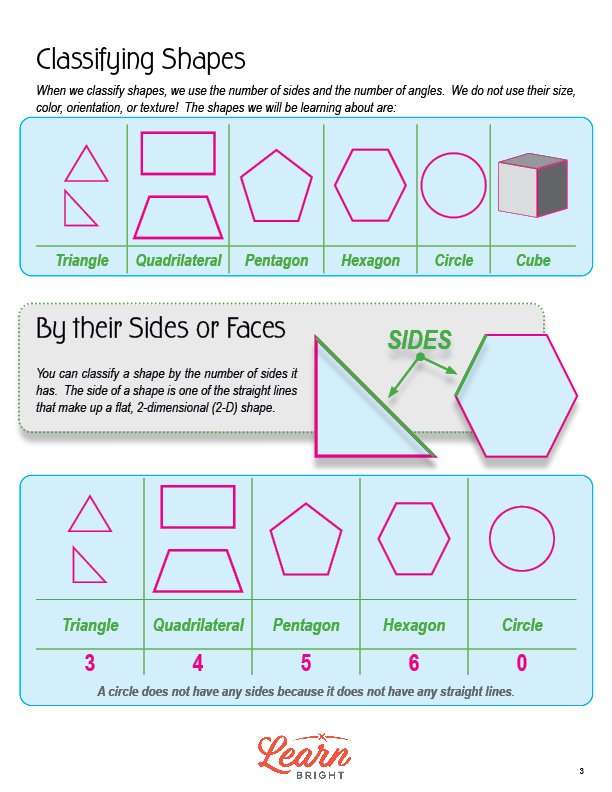Description
What our Classifying Shapes lesson plan includes
Lesson Objectives and Overview: Classifying Shapes teaches students the names and attributes, such as the number of sides and number of angles, of various shapes. At the end of the lesson, students will be able to recognize and draw shapes with specific attributes focusing on triangles, quadrilaterals, pentagons, hexagons, and cubes. This lesson is for students in 2nd grade.
Classroom Procedure
Every lesson plan provides you with a classroom procedure page that outlines a step-by-step guide to follow. You do not have to follow the guide exactly. The guide helps you organize the lesson and details when to hand out worksheets. It also lists information in the blue box that you might find useful. You will find the lesson objectives, state standards, and number of class sessions the lesson should take to complete in this area. In addition, it describes the supplies you will need as well as what and how you need to prepare beforehand.
Options for Lesson
Included with this lesson is an “Options for Lesson” section that lists a number of suggestions for activities to add to the lesson or substitutions for the ones already in the lesson. One optional addition to this lesson is to have students use dry erase boards to draw shapes when the instructor calls out the number of sides or vertices. You can also have your students find shapes in the classroom and classify them by their attributes while keeping a running list of each type of shape and the objects they find.
Teacher Notes
The teacher notes page includes a paragraph with additional guidelines and things to think about as you begin to plan your lesson. This page also includes lines that you can use to add your own notes as you’re preparing for this lesson.
CLASSIFYING SHAPES LESSON PLAN CONTENT PAGES
Classifying Shapes
The Classifying Shapes lesson plan includes two content pages. To classify shapes, we consider the number of sides and the number of angles. We don’t consider the size, color, orientation, or texture. The shapes discussed in this lesson include triangles, quadrilaterals, pentagons, hexagons, circles, and cubes.
By their Sides or Faces
One way to classify a shape is by the number of sides it has. Sides of a shape are the straight lines that create a flat, 2-dimensional shape. Triangles have 3 sides, quadrilaterals have 4, pentagons have 5, hexagons have 6, and circles have 0 because they do not have any straight lines.
For cubes, we call the sides edges and the flat parts faces. Cubes have six faces. This is easy to remember because a dice is a cube!
Be their Vertices
Another way to classify a shape is by the number of vertices it has. Vertices are the angular points of a shape. These are corners, and we just call them vertices in math. Triangles have 3 vertices, quadrilaterals have 4, pentagons have 5, hexagons have 6, circles have 0, and cubes have 8.
The number of sides and number of vertices that a 2-dimensional shape always match. Octagons, for example, have 8 sides and 8 vertices. The lesson includes drawings of two shapes, one regular and one irregular, with 10 sides. Both of these shapes have 10 vertices as well! Circles don’t have any vertices because they don’t have any angular points.
CLASSIFYING SHAPES LESSON PLAN WORKSHEETS
The Classifying Shapes lesson plan includes three worksheets: an activity worksheet, a practice worksheet, and a homework assignment. You can refer to the guide on the classroom procedure page to determine when to hand out each worksheet.
MATCHING ACTIVITY WORKSHEET
Students will work in pairs to complete the activity worksheet. Each pair will cut out both shape descriptions and drawings of shapes. They will then mix the cards up and place them face down on their desk. They will take turns flipping two cards over. If the description and drawing match, they keep both cards. The student with the most cards at the end wins.
CLASSIFYING SHAPES PRACTICE WORKSHEET
The practice worksheet asks students to answer six questions about shapes. They have to draw some shapes and answer questions about how many sides and vertices they have.
SHAPE CHART HOMEWORK ASSIGNMENT
For the homework assignment, students will fill in the missing boxes in a chart that includes the names of shapes, their pictures, the number of vertices for each, and the number of sides for each.
Worksheet Answer Keys
This lesson plan includes answer keys for the practice worksheet and the homework assignment. If you choose to administer the lesson pages to your students via PDF, you will need to save a new file that omits these pages. Otherwise, you can simply print out the applicable pages and keep these as reference for yourself when grading assignments.









